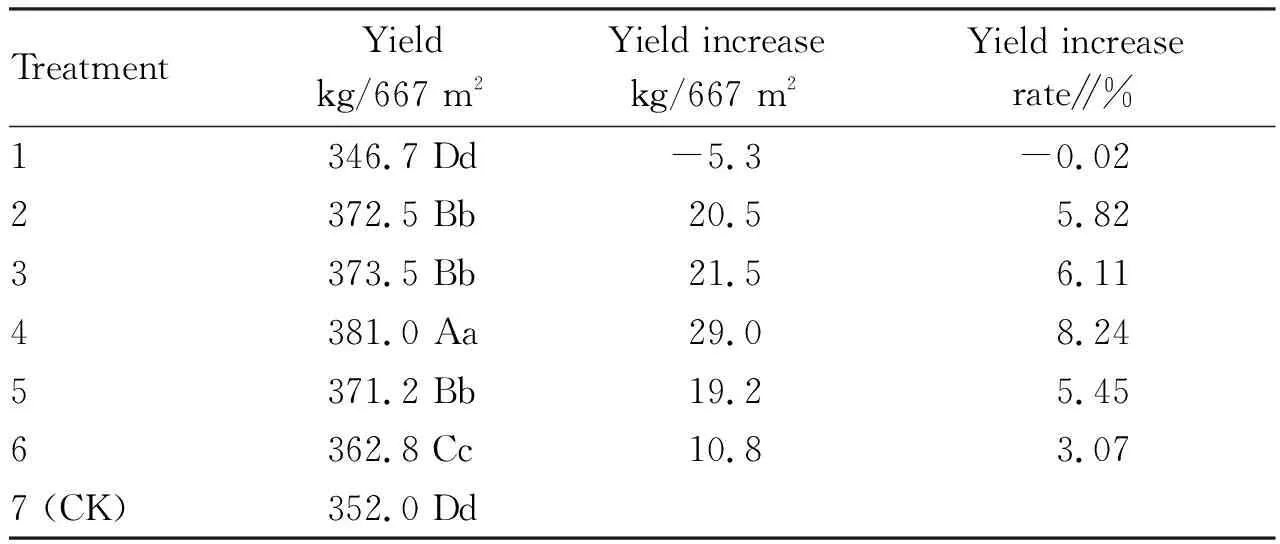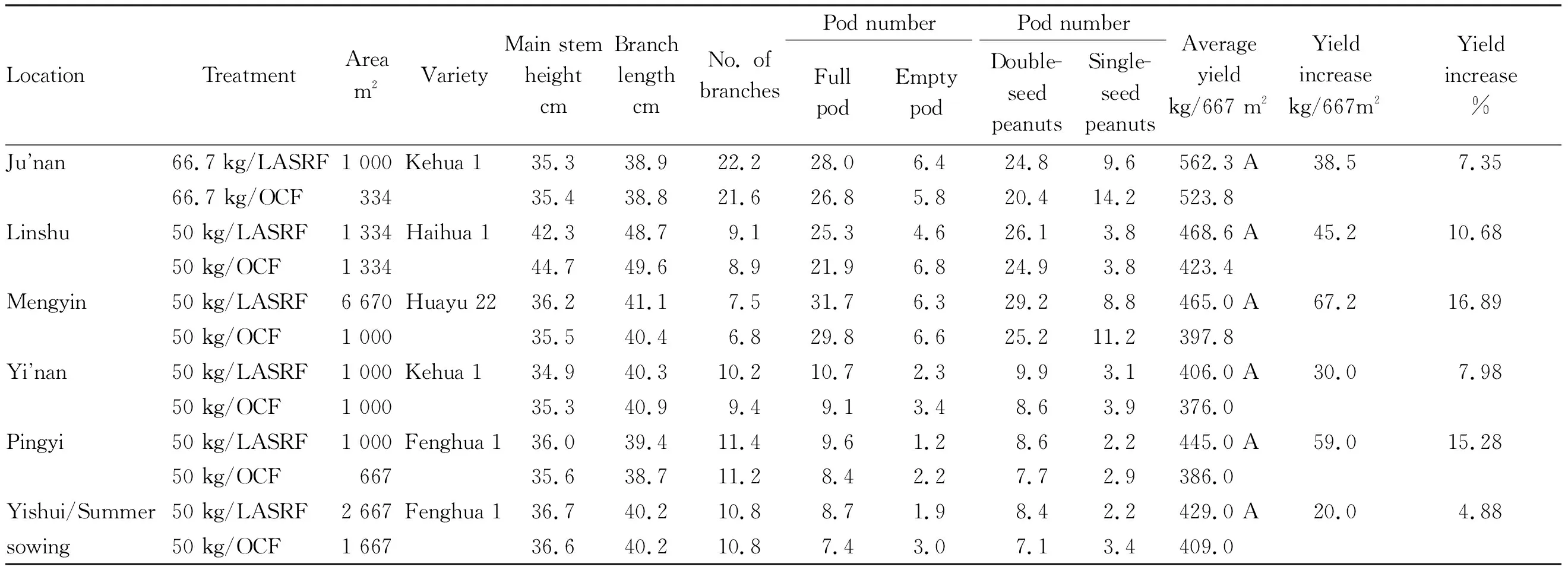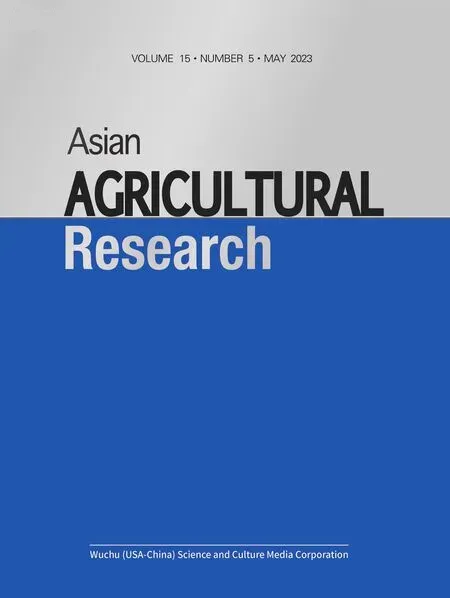Impacts and Demonstration Effects of Applying Long-acting Slow-release Fertilizer on Economic Yield of Peanut
2023-06-28HongjieTANGJiejieZHANGQingfuDUYanxueDANG
Hongjie TANG, Jiejie ZHANG, Qingfu DU, Yanxue DANG
Linyi Academy of Agricultural Sciences, Linyi 276012, China
Abstract [Objectives] To study the impacts and demonstration effects of long-acting slow-release fertilizer application on economic yield of peanut. [Methods] The 25, 30, 35, 40, 45, 50 kg of long-acting slow-release fertilizers were applied to 667 m2 of peanuts, and different amounts of urea were applied together. [Results] Applying 40 kg of long-acting slow-release fertilizer and 10.45 kg of urea had the best effect. Compared with the application of ordinary compound fertilizers, the plants did not age prematurely, the leaf diseases were mild, the stems and leaves remained dark green when harvested, and the stems and leaves had a longer functional period. Bearing shoots increased by 1.7, single-plant full pods increased by 2.4, double-seed peanuts increased by 3.2, empty pods decreased by 0.5, and single-seed peanuts decreased by 0.7. The experimental demonstration results show that the spring-sowed peanuts had an average yield increase of 29.0-67.2 kg/667 m2, and the yield increase rate was 7.35%-16.89%, and the difference was extremely significant. [Conclusions] In the high-yield cultivation of peanuts, the application of long-acting slow-release fertilizer can be promoted to improve peanut production.
Key words Peanut, Long-acting slow-release fertilizer, Economic traits, Yield-increase effect
1 Introduction
Fertilization technology is an important measure in high-yield cultivation of peanuts. The general rules of peanut fertilizer requirement are that the seedling stage and full pod maturity stage require relatively less fertilizer, and the pegging period and podding period require a larger amount of fertilizer. The promotion of peanut mulching cultivation technology restricts the topdressing in the middle and later stages, and the method of fertilization is usually applied at one time. To obtain high yield, peanuts need a lot of fertilizer, especially in the middle and late stages. However, one-time fertilization may easily lead to defertilization in the middle and late stages, premature senescence of plants, decreased resistance, aggravation of leaf diseases, and low yield.
Long-acting slow-release fertilizer is a revolution in fertilizer technology. Its principle is as follows: add a long-acting slow-release agent composed of urease controller, nitrification inhibitor, ammonia stabilizer and phosphorus anti-curing agent to the fertilizer. Through controlling the transformation and formation of nitrogen in the soil, it is possible to slow down the conversion of urea to ammonium nitrogen and nitrate nitrogen, control the ratio of ammonia nitrogen to nitrate nitrogen in the soil, thereby controlling the loss of volatile leaching and denitrification and effectively preventing phosphorus from solidifying too quickly in the soil. The fertilizer efficiency is put off significantly, and the fertilizer utilization rate has increased from 38% to 51%, achieving the goal of long-term and high efficiency.
In order to explore the technical method and application quantity of long-acting slow-release fertilizer for peanut, and to clarify the effect of fertilizer efficiency postpone on yield and economic traits, we tested and demonstrated Shikefeng long-acting slow-release fertilizer application technology in the main peanut production area of Linyi, and achieved good results.
2 Materials and methods
2.1 Test fertilizerShikefeng long-acting slow-release fertilizer (N24P10K14), Yanyangtian compound fertilizer (N15P15K15), and urea [CO(NH2)2].
2.2 Test treatmentAccording to the local farmers’ fertilization habits, we carried out an equivalent test. Taking application of 50 kg Shikefeng long-acting slow-release fertilizer in 667 m2area as a standard control, the total content of nitrogen, phosphorus and potassium per 667 m2of each treatment reached 48%. If the total content of nitrogen, phosphorus and potassium in each treatment was insufficient, it was supplemented with urea. Treatment 1: Shikefeng long-acting slow-release fertilizer 25 kg/667 m2+urea 26.1 kg; Treatment 2: Shikefeng long-acting slow-release fertilizer 30 kg/667 m2+urea 20.9 kg; Treatment 3: Shikefeng long-acting slow-release fertilizer 35 kg/667 m2+urea 15.7 kg; Treatment 4: Shikefeng long-acting slow-release fertilizer 40 kg/667 m2+urea 10.45 kg; Treatment 5: Shikefeng long-acting slow-release fertilizer 45 kg/667 m2+urea 3.05 kg; Treatment 6: Shikefeng long-acting slow-release fertilizer 50 kg/667 m2; Treatment 7 (CK): Yanyangtian compound fertilizer 53.35 kg/667 m2.
2.3 Experimental designThe experimental site is located in Linyi Academy of Agricultural Sciences, with deep soil, flat terrain, convenient drainage and irrigation, alluvial soil, and cabbage as the previous crop. Ridge cultivation, ridge width 83.4 cm, ridge length 8 m, plot area 13.34 m2, two ridge areas. Accurately weighed the long-acting slow-release fertilizer and urea according to the treatment requirements, and applied them intensively in the middle of the ridge. Sowed two rows per ridge, with a minimum row spacing of 20 cm, 2 seeds per hole, and a hole spacing of 17 cm. The plots were randomly arranged and repeated 3 times, a total of 21 plots. The peanut variety used in the experiment was Linhua 6. The peanuts were sowed on May 14, 2009 and harvested on September 18. On July 2, 2009, "35% phoxim microcapsules" was applied to prevent and control grubs, and "Peanut Six No Worry" was sprayed at the end of full flowering for chemical control, and other management was the same as in the field. When harvesting, selected the seeds calculated the yield of the whole area, and investigated the impact on the yield and its economic traits.
3 Results and analysis
3.1 Effects of long-acting slow-release fertilizers on economic traits of peanutsThe experimental results (Table 1) show that: except for treatment 1, the number of branches and bearing shoots of each treatment using long-acting slow-release fertilizers were higher than that of the control, the bearing shoots were 1.1-1.7 more than the control, and the total pod number was increased by 2.5-4.3. Among them, double-seed peanuts increased by 2.2-3.6, full pods increased by 1.9-4.3, and empty pods decreased by 0-0.5. In addition, the number of full pods and double-seed peanuts increased with the increase of Shikefeng long-acting slow-release fertilizer usage. This is because that the long-acting slow-release fertilizer can meet the needs of peanuts for nitrogen, phosphorus and potassium during the whole growth period due to slow release and fertilizer effect postpone. During the formation of photosynthetic products from the pegging period, podding period to full fruit maturity period and the transportation to pods, the supply of nitrogen, phosphorus and potassium is guaranteed. Furthermore, due to no defertilization during the whole growth period, the stems and leaves of peanuts are still dark green when harvested, and the lifespan of functional leaves is prolonged without premature aging, leaf disease is delayed and double-seed peanuts and full pods are greatly improved. Long-acting slow-release fertilizers have good effects on peanut economic traits and are of great significance to increase the peanut yield.

Table 1 Effects of long-acting slow-release fertilizers on economic traits of peanuts
3.2 Effect of long-acting slow-release fertilizer on peanut yieldAccording to experimental results (Table 2), the treatment with application of 40 kg of Shikefeng long-acting slow-release fertilizer and 10.45 kg of urea had the best effect. The average yield of 667 m2land reached 381.0 kg, which was 29.0 kg higher than that of ordinary compound fertilizer per 667 m2, and the yield increase rate was 8.24%, ranking first. The variance analysis showed that the difference with other treatments reached an extremely significant level. The treatment of applying Shikefeng long-acting slow-release fertilizer 30, 35, and 45 kg to 667 m2land, increased the yield by 19.2-21.5 kg compared with the control, and the yield increase rate was 5.45%-6.11%. There were no significant differences among the three treatments, but extremely significant differences with other treatments. The treatment of applying 50 kg Shikefeng long-acting slow-release fertilizer in 667 m2land had the yield increase rate of 3.08%, showing an extremely significant difference with the control. The treatment with application of 25 kg Shikefeng long-acting slow-release fertilizer and 26.1 kg urea in 667 m2land had the worse effect, with the yield decrease by 5.3 kg and no significant difference with the control.

Table 2 Effects of long-acting slow-release fertilizer on peanut yield
3.3 Demonstration effects of long-acting slow-release fertilizerWe carried out demonstrations of long-acting slow-release fertilizers in Ju’nan County, Linshu County, Mengyin County, Yi’nan County, Pingyi County, and Yishui County, which are the main peanut production areas, and the demonstration effects were good. The long-acting slow-release fertilizer demonstration in each county was compared with the local fertilization habits. The demonstration results (Table 3) indicate that the application of long-acting slow-release fertilizers has a significant yield-increasing effect compared with ordinary compound (mixed) fertilizers. Except for the 4.88% increase in yield of summer peanuts in Yishui (the previous stubble was watermelon, fertile soil), and other demonstration sites for spring peanuts had a relatively large increase in yield. The soil and fertility of the demonstration plots are different, the levels of soil miscellaneous fertilizers and organic fertilizers are different, and the previous crops were different. Compared with the application of ordinary compound fertilizers, the application of long-acting slow-release fertilizers, due to the postpone effect of fertilizers, the stems and leaves were generally dark green when harvested, the functional period of stems and leaves was significantly prolonged, there was no premature aging phenomenon, and the occurrence of leaf spot and peanut web blotch was delayed. The double-seed peanuts and full pod rate were increased, and the yield was increased by 30.0-67.2 kg/667 m2, and the yield increase rate was 7.35%-16.89%.

Table 3 Demonstration effects of long-acting slow-release fertilizer for peanuts
4 Conclusions
Applying Shikefeng long-acting slow-release fertilizer to peanuts can promote the robustness of the peanut plants. Peanuts can be supplied with nutrients throughout the growth period without defertilization. In the middle and late stages of growth, even no foliar fertilizer is sprayed, the peanut stems and leaves can still have a long functional period. The stems and leaves do not age prematurely, the disease resistance is improved, the occurrence of leaf diseases was less, the rate of double-seed peanuts and the rate of full fruit were increased, and the yield was increased by 30.0-67.2 kg/667 m2compared with ordinary compound fertilizers, and the yield increase rate was 7.35%-16.89%. Due to the slow release of long-acting slow-release fertilizers, peanuts need more nitrogen fertilizers in the early stage. Especially from seedling emergence to flowering, this period is a critical period for peanut branching. Appropriate application of urea can make up for the need for nitrogen fertilizer in the early stage of peanut growth, and plays an important role in forming suitable populations in the late stage. Therefore, in the high-yield cultivation of peanuts, the application of long-acting slow-release fertilizers can be promoted to increase the yield of peanuts. The specific method is to apply 40 kg of Shikefeng long-acting slow-release fertilizer and 10 kg of urea/667 m2, and intensively apply the fertilizer in the middle of the ridge.
杂志排行
Asian Agricultural Research的其它文章
- Analysis on Value Rationality of Traditional Farm Tools in the Taomin Area
- Techniques and Precautions of Sod Culture in Citrus Orchards in Sichuan Province
- Research Progress in Biological Control of Soft Rot of Amorphophallus konjac
- Treatment of Heavy Metal Pollution in Sediment and Its Resource Utilization in Building Ceramics
- Silage Fermentation Technology and Its Effects on Growth Performance of Local Pigs
- Effects of Different Dwarfing Rootstocks on Growth, Yield and Fruit Quality of ‘Tianhong 2’ Apple Trees
